Warning: pic heavy, as usual. 
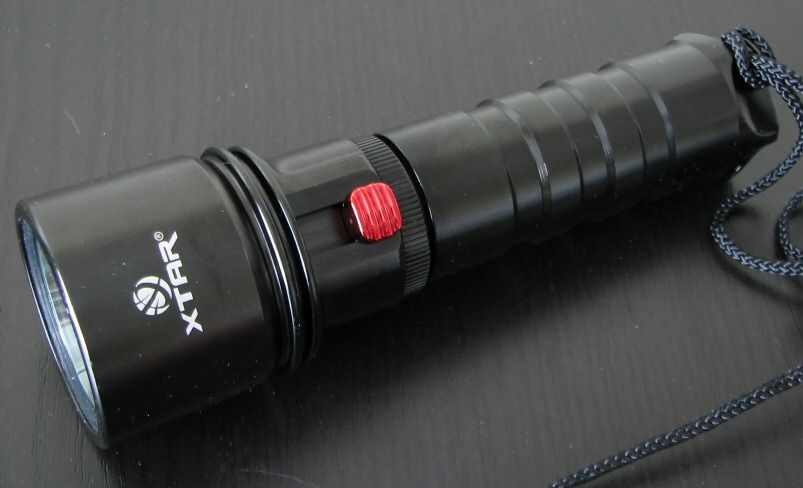
Specifications:

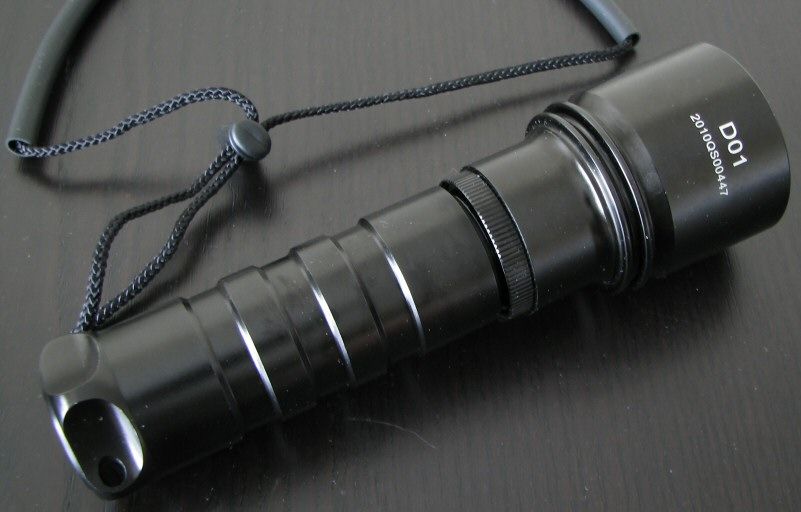
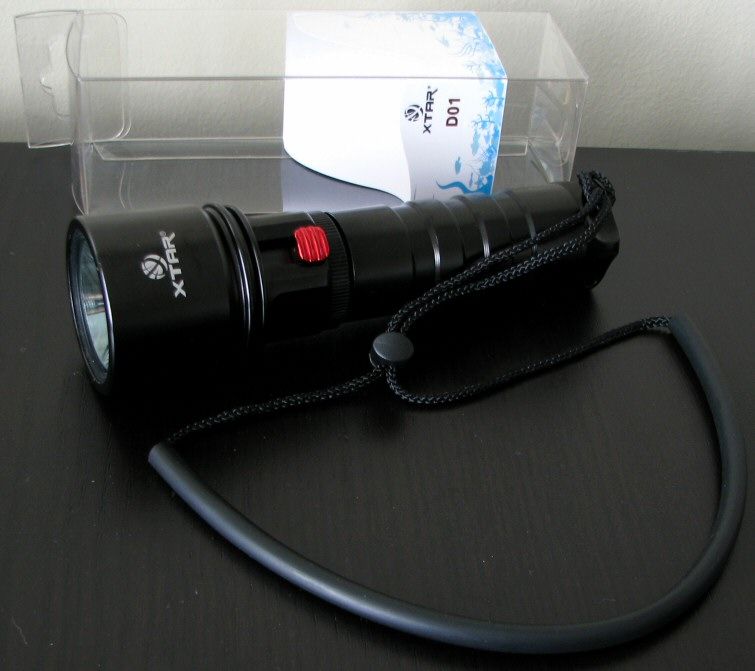
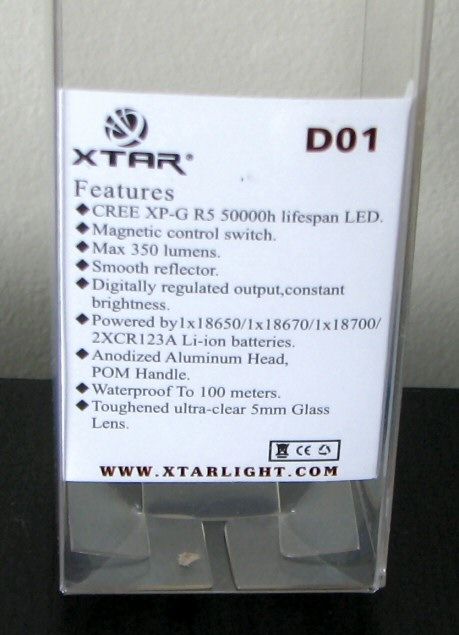
Packaging is very basic - inside the plastic box is the light, with a removable wrist strap attached. Simple instructions are included on the back of the cardboard insert in the box. There were no spare o-rings on my sample.
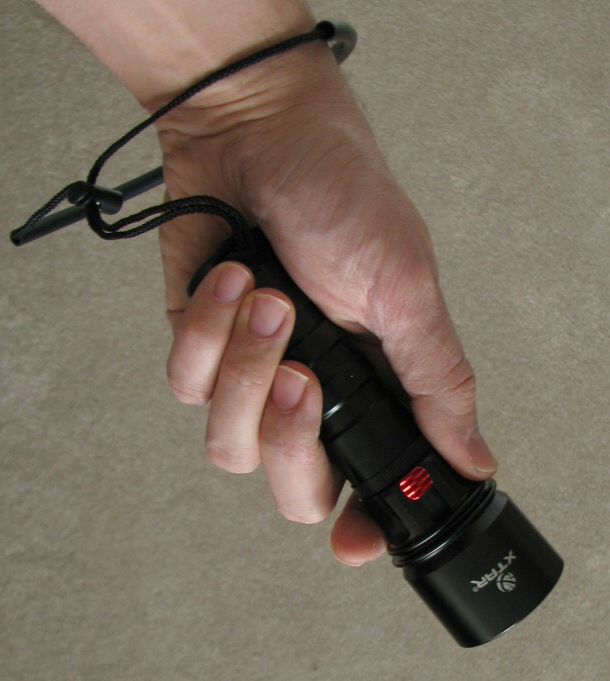
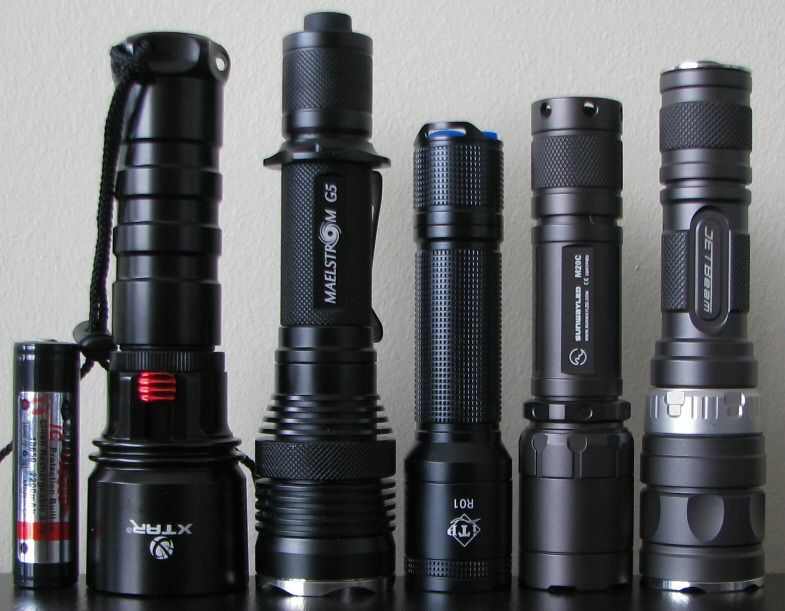
From left to right: AW protected 18650, Xtar D01, 4Sevens Maelstrom G5, ITP R01, Sunwayman M20C, JetBeam RRT-2
D01: Weight: 220.1g (no battery), Length 148.1mm x Width 44.7mm (bezel)
The light is quite heavy for this class, and the overall dimensions are rather beefy. As you will see below, body wall thickness is remarkably high on the D01.
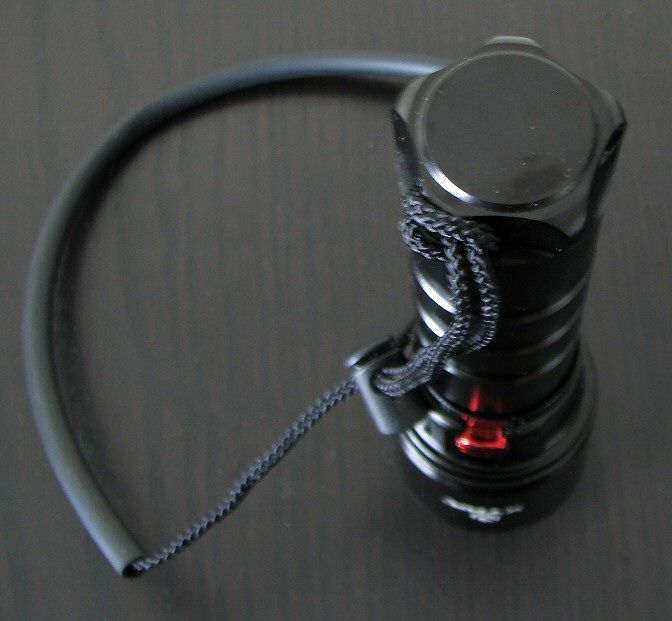
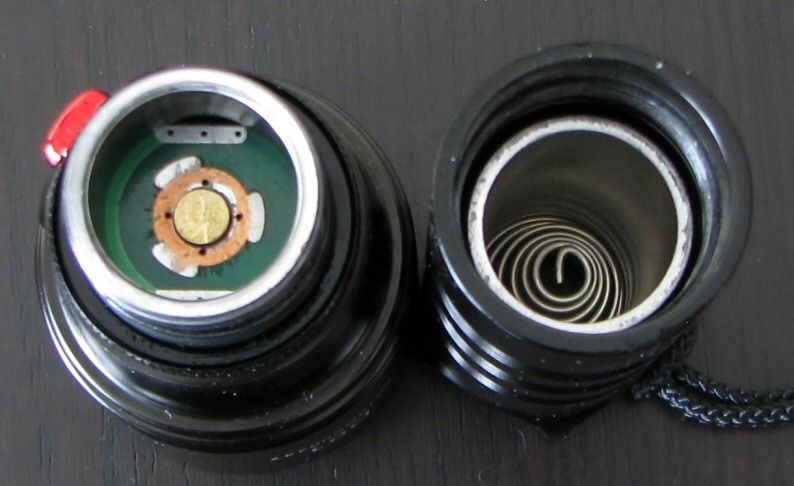
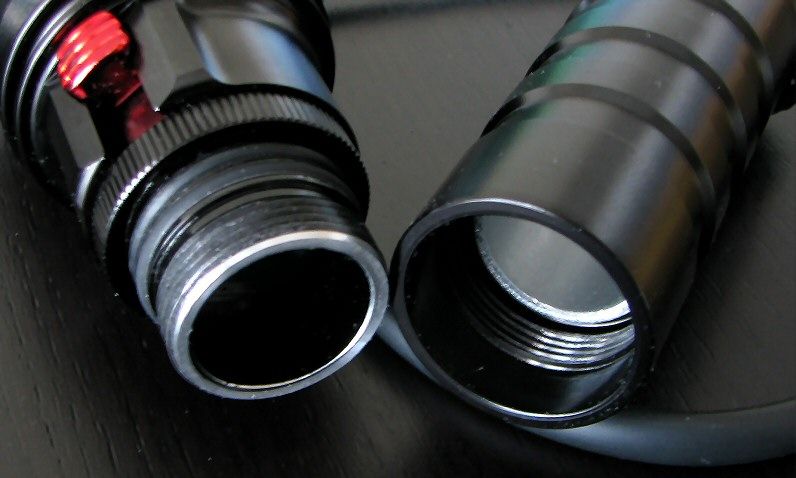
The light doesn't use a tailcap switch – rather, that's a pretty hefty piece of aluminum for the battery tube/handle. oo: You will notice there seems to be an inner core tube as well as the exterior aluminum casing. There is a solid-looking spring at the base.
oo: You will notice there seems to be an inner core tube as well as the exterior aluminum casing. There is a solid-looking spring at the base.
Light can tailstand. The light lacks any kind of knurling, but has some concentric ring designs to help with grip. Still, I would consider this light rather slippery with wet hands, so you should use the included wrist-strap. The lack of knurling may be intentional for a dive light (i.e. you wouldn't want it catching or ripping on a wetsuit).
Anodizing is excellent on my sample, no chips in the black finish (HA = type III). Lettering is sharp and clear, bright against the shiny black background.
There is a raised contact disc at the positive battery terminal in the head, so flat-top cells will work fine.
Note the double o-rings on the head, to insure waterproofness (up to 100m claimed).
Light features anodized screw threads, so you need to tighten all the way for the light to come on. Output intensity is controlled by the red aluminum magnetic switch (scroll down for a discussion of the UI).
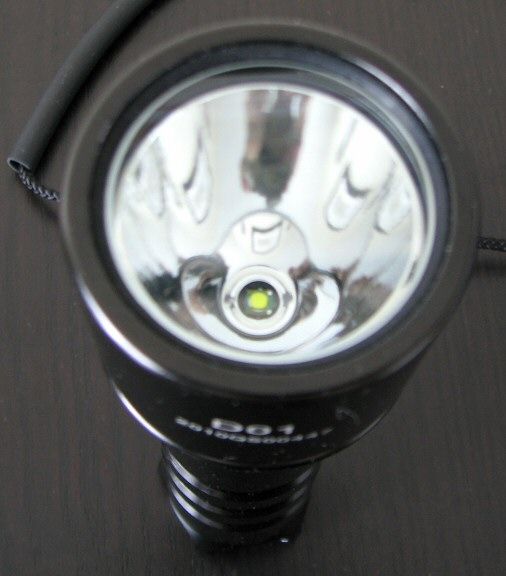
The D01 features the Cree XP-G emitter, R5 output bin. The reflector is smooth, but there are some slight concentric rings in it. I've seen this before – I can only assume it helps to reduce artifacts/rings in the beam, without going for full texturing. This will likely produce decent throw.
Which brings us to the requisite white wall hunting . All lights are on Hi on 18650 (AW Protected where available), about ~0.75 meter from a white wall (with the camera ~1.25 meters back from the wall). Automatic white balance on the camera, to minimize tint differences.
. All lights are on Hi on 18650 (AW Protected where available), about ~0.75 meter from a white wall (with the camera ~1.25 meters back from the wall). Automatic white balance on the camera, to minimize tint differences.
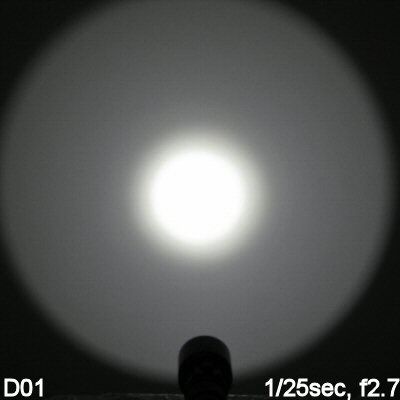
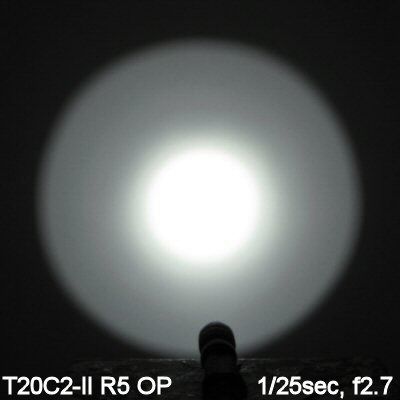
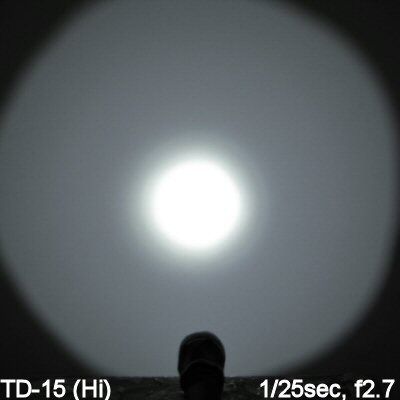
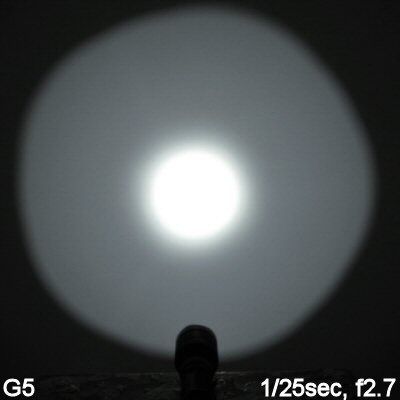
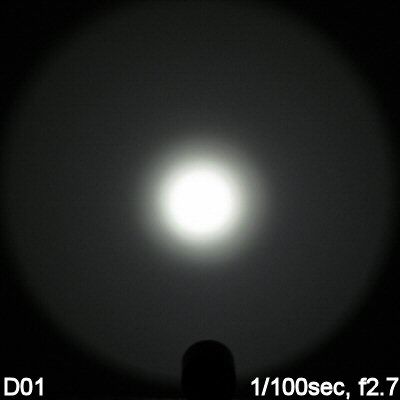
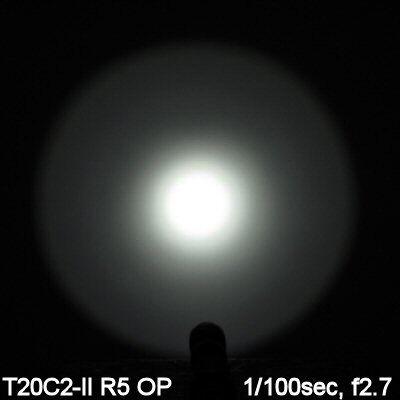
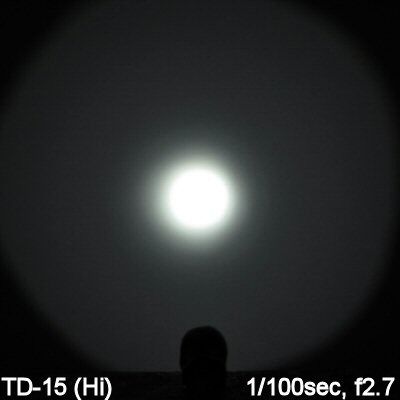
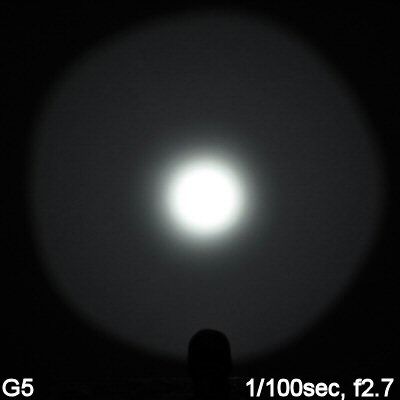
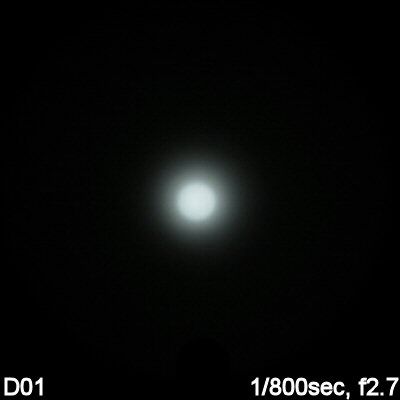
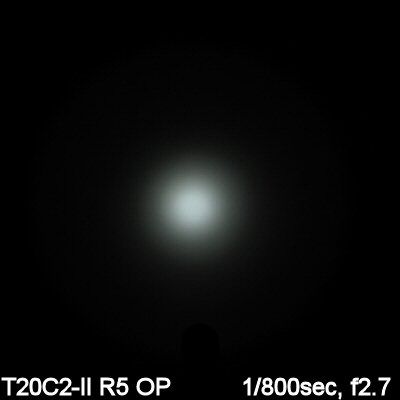
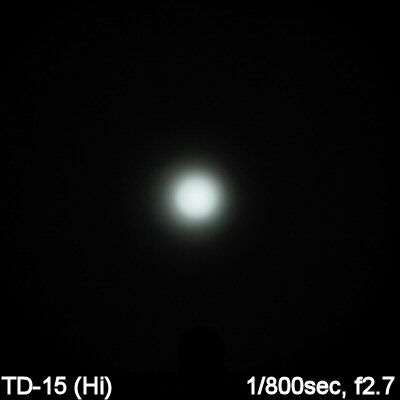
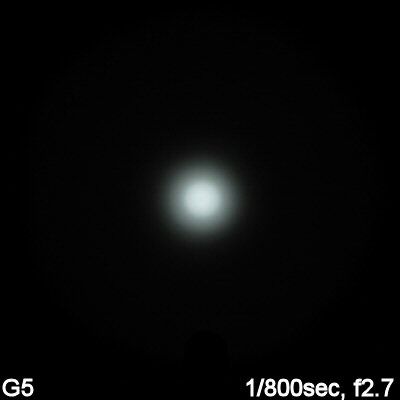
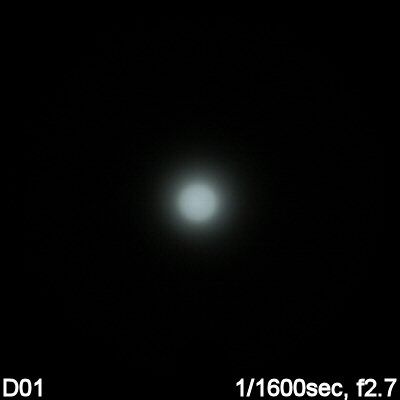
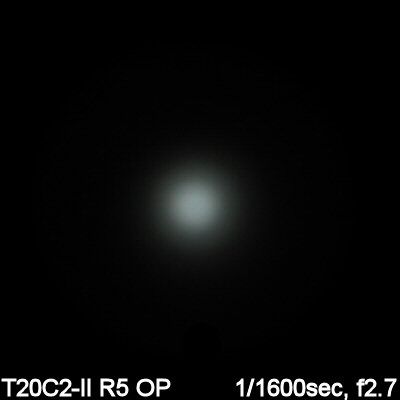
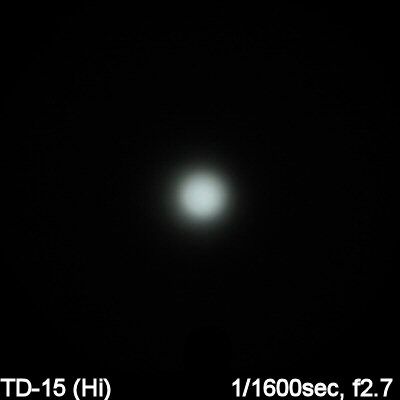
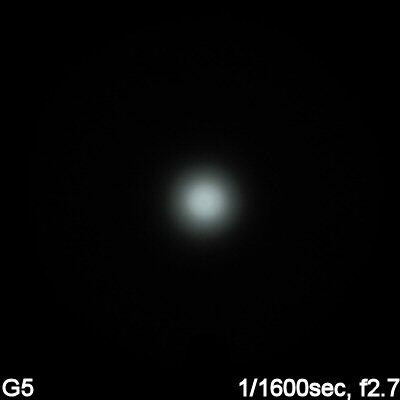
As you can see, the D01 is well focused for throw, with a tight hotspot. It basically throws about as well as my Maelstrom G5. oo:
oo:
Scroll down to my Summary Tables for more specifics on output and throw.
UPDATE: I will soon update my 100-Yard Outdoor Beamshot Round-up with additional lights, including the D01. Check out that round-up thread for more details on the testing method, plus higher quality JPEG images of all lights. For now, here is an animated GIF of relevant D01/G5/TD15 comparisons:
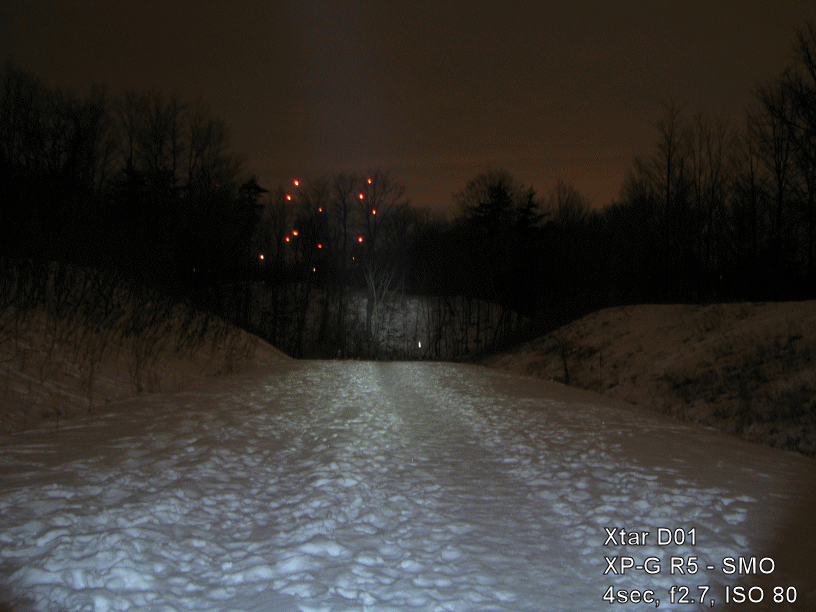
Note that the snowfall combined with moonlight and nearby city lights causes a lot of ambient light reflection (i.e. background brightness is much higher than on other comparisons). The snow also causes a lot more diffusion of the hotspots and spillbeams, again due to reflections. This made it hard to consistently aim the lights, so there may more than usual variation on my part - please take that into account when comparing the hotspots and coronas.
User Interface
This is another unique feature of the light. On the head, you will note a red aluminum switch - this is a magnetic control switch. With the head fully tightened, slide it up from the bottom (Standby mode) to move through a series of outputs, finally to Max at the top.
The light is not truly continuously-variable – there is a noticeable step progression in outputs, and I can count ~20 discrete levels. Note the traverse of the switch is only about 1cm or so, it can be a bit tricky to specifically identify all the levels. Below is a graph of the estimated lumen output of each level I could elicit (I may be missing one or two, though):
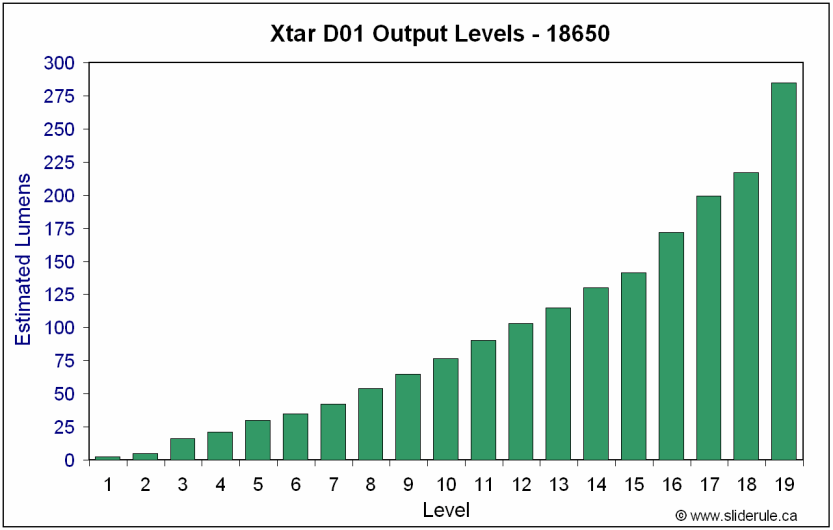
While not perfectly visually-linear, it definitely seems like they have made an effort to make it so. It is certainly is not linear for actual drive currents (i.e. that would produce a much more logarithmic looking graph, given how the eye interprets relative output).
There is a brief flash when the head is tightened against the body, even if the switch is set to Standby (i.e. the lowest part of its traverse). Given the standby mode, there must be a parasitic standby current when the head is fully connected. However, I was unable to measure the specific current on my sample (i.e. I could elicit the flash by making contact, but was unable to keep sustained contact for constant output and current measures). :shrug:
As always, I recommend you lock out the head when the light is not in use.
PWM
The D01 actually uses two different visible PWM frequencies over its range of outputs:
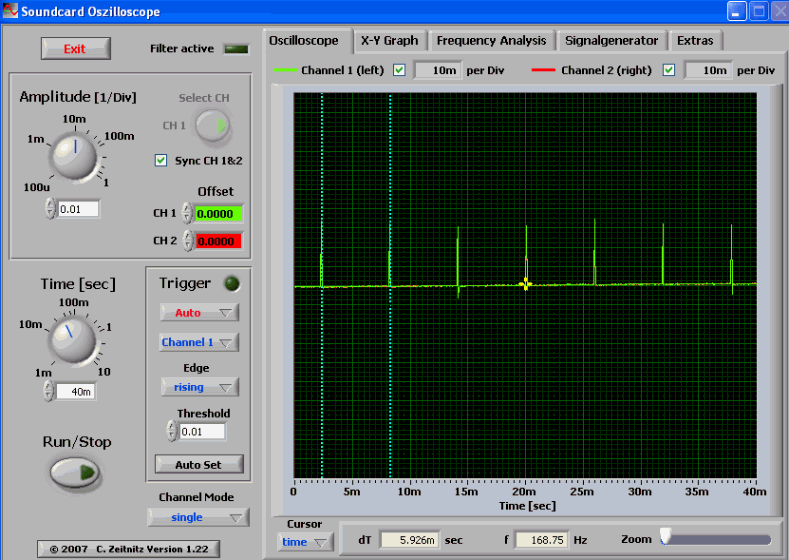
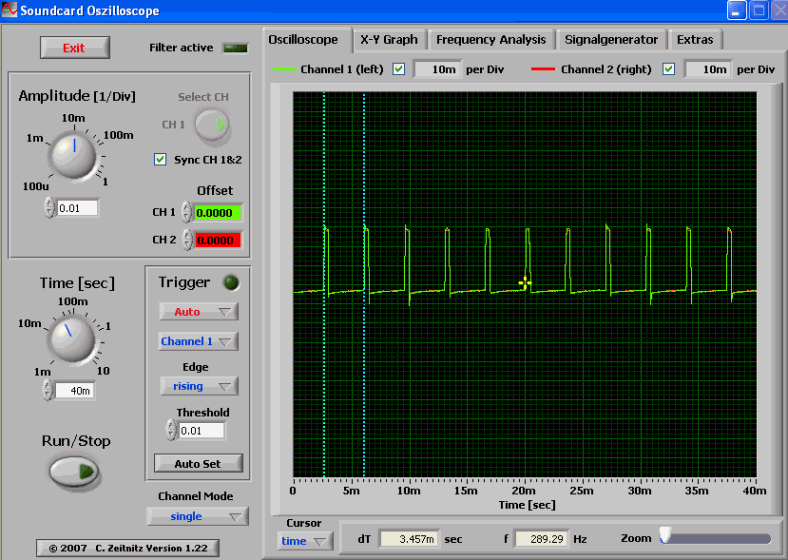
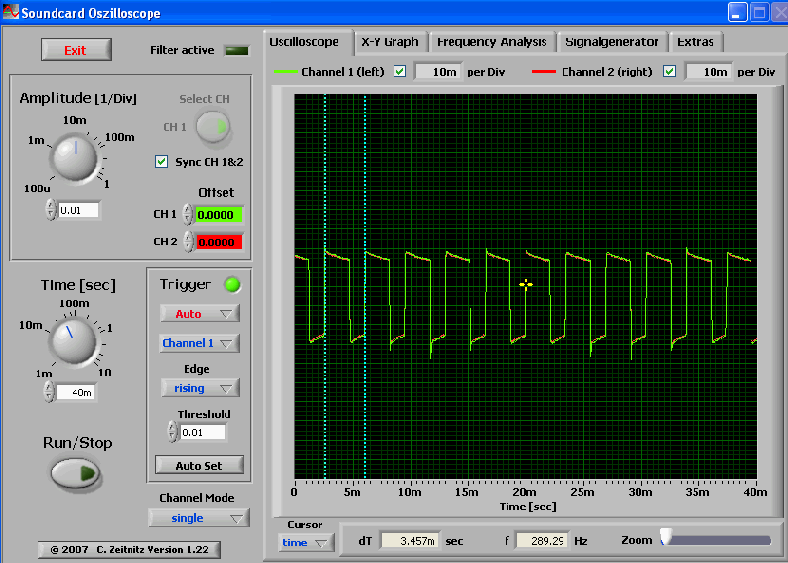
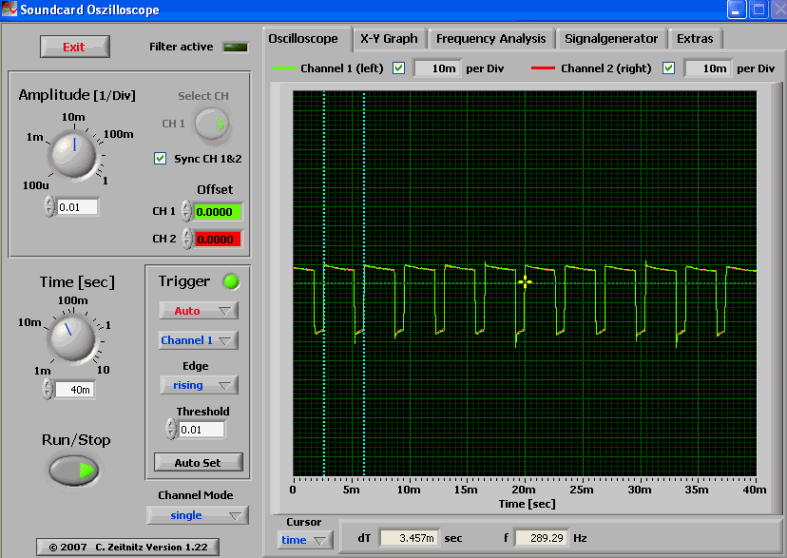
PWM is 290 Hz over most of the output range of the light. However, at the very lowest level, PWM drops to ~169 Hz.
Testing Method:
All my output numbers are relative for my home-made light box setup, a la Quickbeam's flashlightreviews.com method. You can directly compare all my relative output values from different reviews - i.e. an output value of "10" in one graph is the same as "10" in another. All runtimes are done under a cooling fan, except for any extended run Lo/Min modes (i.e. >12 hours) which are done without cooling.
I have recently devised a method for converting my lightbox relative output values (ROV) to estimated Lumens. See my How to convert Selfbuilt's Lighbox values to Lumens thread for more info.
Throw/Output Summary Chart:
Effective November 2010, I have revised my summary tables to match with the current ANSI FL-1 standard for flashlight testing. Please see http://www.sliderule.ca/FL1.htm for a description of the terms used in these tables.
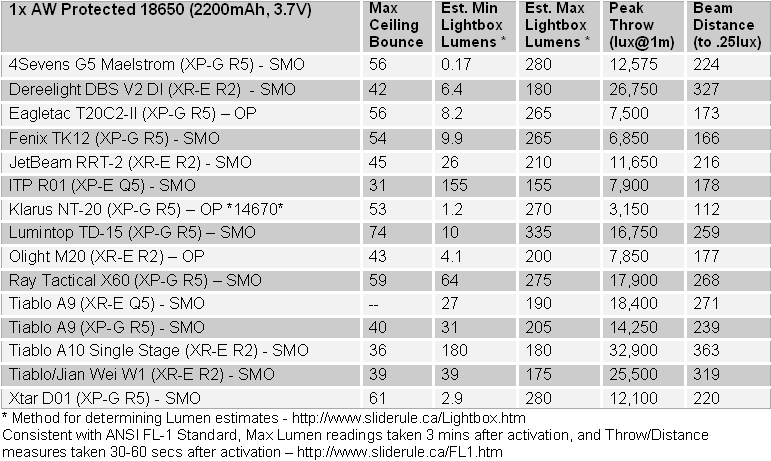
The max output and throw of the D01 are consistent with its emitter and reflector design. It's max output is consistent with many lights in this class.
Output/Runtime Comparison:
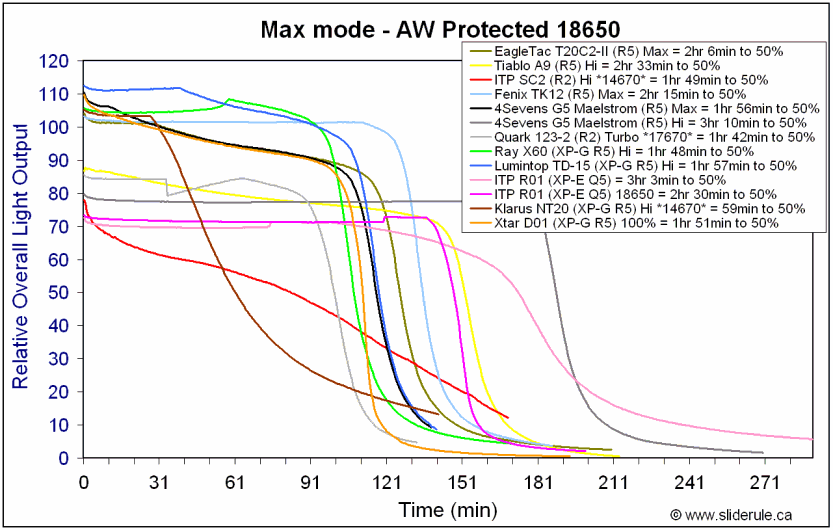
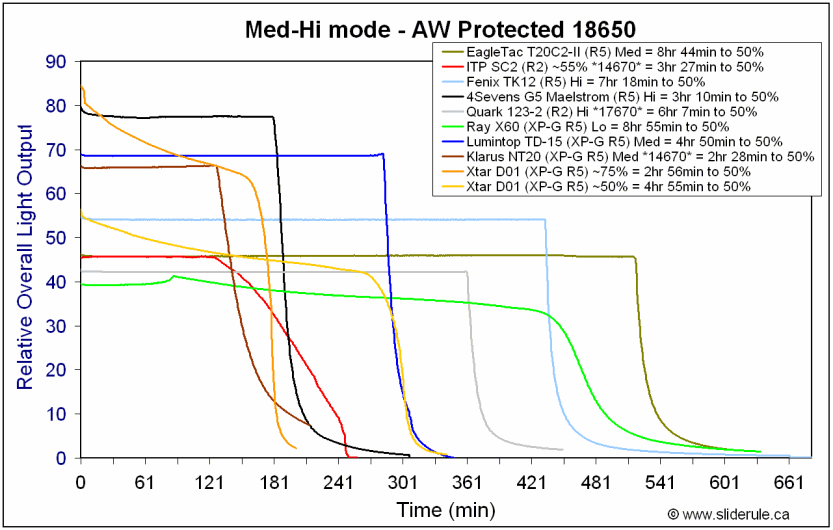
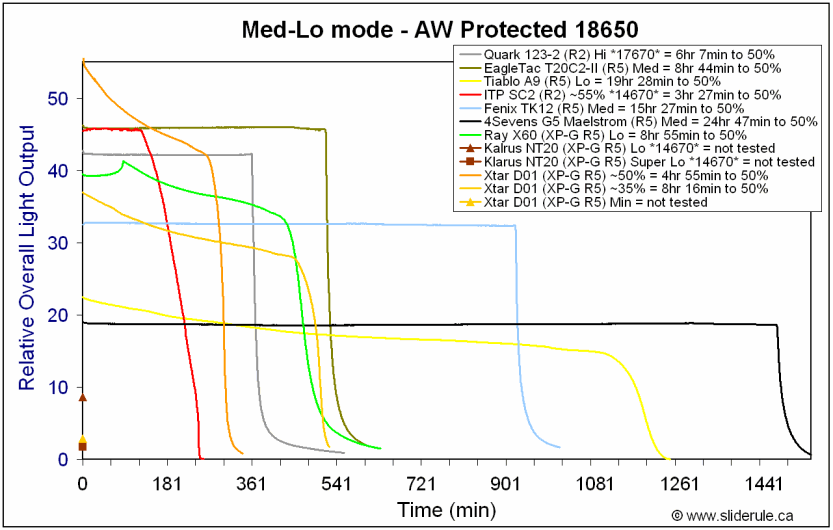
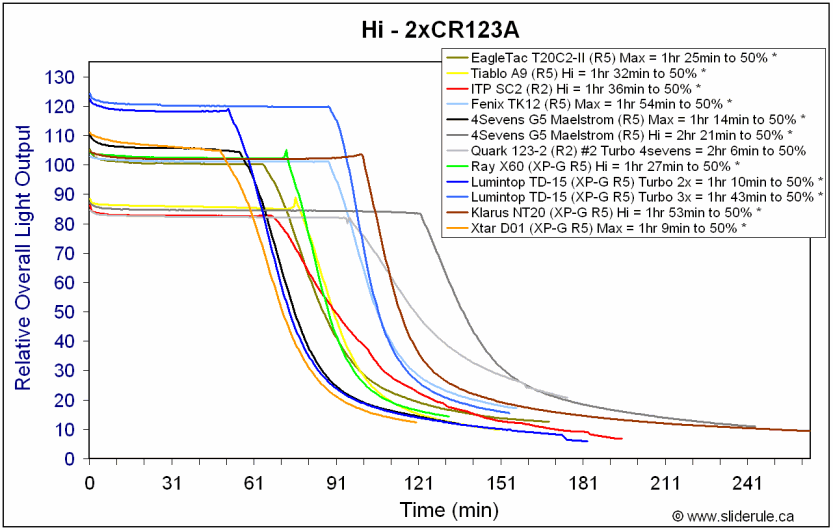
Output and runtime on Max, on all batteries, is quite typical for the class.
The light seems to be only semi-regulated on 18650, even at the lower output levels. Runtimes are reasonable for the class, at all levels tested.
Potential Issues
Light is heavier than most lights of this class, but that may be related in part to its 100 meter dive-rated status.
Light uses visible PWM at all output levels except Max output (i.e. 169-290 Hz)
There is a standby current when the head is fully tightened, but this can be cut by simply loosening the head a quarter-turn when not in use (i.e. threads are anodized).
Light lacks any extras, except for a wrist strap (i.e. no carrying case, extra o-rings, etc.).
Preliminary Observations
The D01 is a distinctive light - it has a number of features that I haven't seen before. :thumbsup:
First off, I don't see many lights dive-rated for 100 meters. I suspect that accounts in part for the rather beefy build of this light – the double-thickness battery tube especially lends it a lot of heft. Frankly, I think this is probably a little over done (but at least there are no worries about crushing this light! )
)
The most interesting and innovative features of the light are the magnetic control switch and UI. Most lights that use a magnetic control mechanism do so with a ring around the circumference of the light. Instead, the D01 uses a sliding linear switch. This is actually a clever design for a dive light – the weakest part of any waterproofing is the switch, since it usually involves the transfer of movement through the light wall/tailcap. With a magnetic switch, problem solved.
I am surprised to see a continuously-variable interface here (well, 20 levels anyway – most continuously-variable lights are 100+ levels). The levels are well-spaced visually. :thumbsup: I would have liked a slightly longer traverse of the switch (i.e. it is only about 1cm, making it hard sometimes to fine-tune your desired output level). The texturing and coloring of the switch make it easy to spot and use, but it is stiffer than most control rings.
Performance is what you would expect for a XP-G R5-equipped light. Runtimes on 18650 were reasonable for the output, but the light seems to be only semi-regulated at all levels. But that's not a problem – you wouldn't notice the extremely slow drop-off over time (and with a nearly continuously-variable interface, you can always adjust output to suit your needs). Note the light cannot use 2xRCR (voltage range is up to only 7V).
PWM if noticeable at all levels, but at what I would consider to be minimally acceptable rate (i.e. typically 290 Hz). :shrug:
All-in-all, I found this a fun little light to play with. While certainly not your typical pocket-carry (given the weight), it does have a number of interesting design innovations.
P.S.: For those looking for a 18650-charger, I have just reviewed two of Xtar's offerings in this space: Xtar WP2 and MP1
----
D01 provided by Xtar for review.

Specifications:
- LED: CREE XP-G R5
- Electrode-less magnetic control switch
- 350 max luminous flux
- Good condensing smooth reflector
- 250m max range (on land)
- Constant circuit constant brightness
- Powered by 1*18650 / 18700 / 2*CR123A battery
- Ordinary anodized Aluminum embedded POM body, anodized aircraft 6061 aluminum head
- 100m deep diving sealed compression resisted design
- Safety switch design
- 5mm toughened glass
- 3.7~7.0V voltage range
- 198g net weight:
- 44.77mm(head diameter) * 30.00mm(body diameter) * 143.50mm(length)
- Lanyard, package attached
- Estimated street price: ~$65



Packaging is very basic - inside the plastic box is the light, with a removable wrist strap attached. Simple instructions are included on the back of the cardboard insert in the box. There were no spare o-rings on my sample.


From left to right: AW protected 18650, Xtar D01, 4Sevens Maelstrom G5, ITP R01, Sunwayman M20C, JetBeam RRT-2
D01: Weight: 220.1g (no battery), Length 148.1mm x Width 44.7mm (bezel)
The light is quite heavy for this class, and the overall dimensions are rather beefy. As you will see below, body wall thickness is remarkably high on the D01.



The light doesn't use a tailcap switch – rather, that's a pretty hefty piece of aluminum for the battery tube/handle.
Light can tailstand. The light lacks any kind of knurling, but has some concentric ring designs to help with grip. Still, I would consider this light rather slippery with wet hands, so you should use the included wrist-strap. The lack of knurling may be intentional for a dive light (i.e. you wouldn't want it catching or ripping on a wetsuit).
Anodizing is excellent on my sample, no chips in the black finish (HA = type III). Lettering is sharp and clear, bright against the shiny black background.
There is a raised contact disc at the positive battery terminal in the head, so flat-top cells will work fine.
Note the double o-rings on the head, to insure waterproofness (up to 100m claimed).
Light features anodized screw threads, so you need to tighten all the way for the light to come on. Output intensity is controlled by the red aluminum magnetic switch (scroll down for a discussion of the UI).

The D01 features the Cree XP-G emitter, R5 output bin. The reflector is smooth, but there are some slight concentric rings in it. I've seen this before – I can only assume it helps to reduce artifacts/rings in the beam, without going for full texturing. This will likely produce decent throw.
Which brings us to the requisite white wall hunting
















As you can see, the D01 is well focused for throw, with a tight hotspot. It basically throws about as well as my Maelstrom G5.
Scroll down to my Summary Tables for more specifics on output and throw.
UPDATE: I will soon update my 100-Yard Outdoor Beamshot Round-up with additional lights, including the D01. Check out that round-up thread for more details on the testing method, plus higher quality JPEG images of all lights. For now, here is an animated GIF of relevant D01/G5/TD15 comparisons:

Note that the snowfall combined with moonlight and nearby city lights causes a lot of ambient light reflection (i.e. background brightness is much higher than on other comparisons). The snow also causes a lot more diffusion of the hotspots and spillbeams, again due to reflections. This made it hard to consistently aim the lights, so there may more than usual variation on my part - please take that into account when comparing the hotspots and coronas.
User Interface
This is another unique feature of the light. On the head, you will note a red aluminum switch - this is a magnetic control switch. With the head fully tightened, slide it up from the bottom (Standby mode) to move through a series of outputs, finally to Max at the top.
The light is not truly continuously-variable – there is a noticeable step progression in outputs, and I can count ~20 discrete levels. Note the traverse of the switch is only about 1cm or so, it can be a bit tricky to specifically identify all the levels. Below is a graph of the estimated lumen output of each level I could elicit (I may be missing one or two, though):

While not perfectly visually-linear, it definitely seems like they have made an effort to make it so. It is certainly is not linear for actual drive currents (i.e. that would produce a much more logarithmic looking graph, given how the eye interprets relative output).
There is a brief flash when the head is tightened against the body, even if the switch is set to Standby (i.e. the lowest part of its traverse). Given the standby mode, there must be a parasitic standby current when the head is fully connected. However, I was unable to measure the specific current on my sample (i.e. I could elicit the flash by making contact, but was unable to keep sustained contact for constant output and current measures). :shrug:
As always, I recommend you lock out the head when the light is not in use.
PWM
The D01 actually uses two different visible PWM frequencies over its range of outputs:




PWM is 290 Hz over most of the output range of the light. However, at the very lowest level, PWM drops to ~169 Hz.
Testing Method:
All my output numbers are relative for my home-made light box setup, a la Quickbeam's flashlightreviews.com method. You can directly compare all my relative output values from different reviews - i.e. an output value of "10" in one graph is the same as "10" in another. All runtimes are done under a cooling fan, except for any extended run Lo/Min modes (i.e. >12 hours) which are done without cooling.
I have recently devised a method for converting my lightbox relative output values (ROV) to estimated Lumens. See my How to convert Selfbuilt's Lighbox values to Lumens thread for more info.
Throw/Output Summary Chart:
Effective November 2010, I have revised my summary tables to match with the current ANSI FL-1 standard for flashlight testing. Please see http://www.sliderule.ca/FL1.htm for a description of the terms used in these tables.

The max output and throw of the D01 are consistent with its emitter and reflector design. It's max output is consistent with many lights in this class.
Output/Runtime Comparison:




Output and runtime on Max, on all batteries, is quite typical for the class.
The light seems to be only semi-regulated on 18650, even at the lower output levels. Runtimes are reasonable for the class, at all levels tested.
Potential Issues
Light is heavier than most lights of this class, but that may be related in part to its 100 meter dive-rated status.
Light uses visible PWM at all output levels except Max output (i.e. 169-290 Hz)
There is a standby current when the head is fully tightened, but this can be cut by simply loosening the head a quarter-turn when not in use (i.e. threads are anodized).
Light lacks any extras, except for a wrist strap (i.e. no carrying case, extra o-rings, etc.).
Preliminary Observations
The D01 is a distinctive light - it has a number of features that I haven't seen before. :thumbsup:
First off, I don't see many lights dive-rated for 100 meters. I suspect that accounts in part for the rather beefy build of this light – the double-thickness battery tube especially lends it a lot of heft. Frankly, I think this is probably a little over done (but at least there are no worries about crushing this light!
The most interesting and innovative features of the light are the magnetic control switch and UI. Most lights that use a magnetic control mechanism do so with a ring around the circumference of the light. Instead, the D01 uses a sliding linear switch. This is actually a clever design for a dive light – the weakest part of any waterproofing is the switch, since it usually involves the transfer of movement through the light wall/tailcap. With a magnetic switch, problem solved.
I am surprised to see a continuously-variable interface here (well, 20 levels anyway – most continuously-variable lights are 100+ levels). The levels are well-spaced visually. :thumbsup: I would have liked a slightly longer traverse of the switch (i.e. it is only about 1cm, making it hard sometimes to fine-tune your desired output level). The texturing and coloring of the switch make it easy to spot and use, but it is stiffer than most control rings.
Performance is what you would expect for a XP-G R5-equipped light. Runtimes on 18650 were reasonable for the output, but the light seems to be only semi-regulated at all levels. But that's not a problem – you wouldn't notice the extremely slow drop-off over time (and with a nearly continuously-variable interface, you can always adjust output to suit your needs). Note the light cannot use 2xRCR (voltage range is up to only 7V).
PWM if noticeable at all levels, but at what I would consider to be minimally acceptable rate (i.e. typically 290 Hz). :shrug:
All-in-all, I found this a fun little light to play with. While certainly not your typical pocket-carry (given the weight), it does have a number of interesting design innovations.
P.S.: For those looking for a 18650-charger, I have just reviewed two of Xtar's offerings in this space: Xtar WP2 and MP1
----
D01 provided by Xtar for review.
Last edited:

